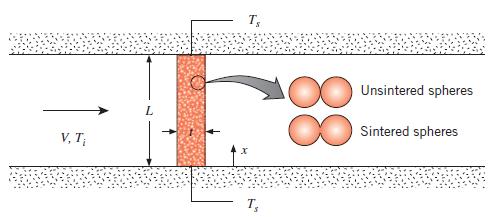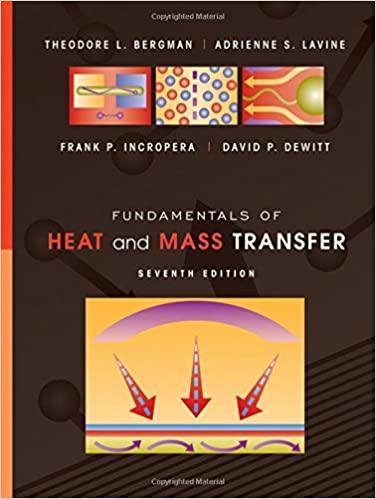Consider Problem 7.113. Estimate the heat transfer rate to the air, accounting for both the increase in
Question:
Consider Problem 7.113. Estimate the heat transfer rate to the air, accounting for both the increase in the air temperature as it flows through the foam and the thermal resistance associated with conduction in the foam in the x-direction. Do you expect the actual heat transfer rate to the air to be equal to, less than, or greater than the value you have calculated?
Data From Problem 7.113
Packed beds of spherical particles can be sintered at high temperature to form permeable, rigid foams. A foam sheet of thickness t = 10mm is comprised of sintered bronze spheres, each of diameter D = 0.6 mm. The metal foam has a porosity of ε = 0.25, and the foam sheet fills the cross section of an L = 40mm W = 40mm wind tunnel. The upper and lower surfaces of the foam are at temperatures Ts = 80°C, and the two other foam edges (the front edge shown in the schematic and the corresponding back edge) are insulated. Air flows in the wind tunnel at an upstream temperature and velocity of Ti = 20°C and V = 10 m/s, respectively.

(a) Assuming the foam is at a uniform temperature Ts, estimate the convection heat transfer rate to the air. Do you expect the actual heat transfer rate to be equal to, less than, or greater than your estimated value?
(b) Assuming one-dimensional conduction in the x-direction, use an extended surface analysis to estimate the heat transfer rate to the air. To do so, show that the effective perimeter associated with Equation 3.70 is Peff = Ap,t /L. Determine the effective thermal conductivity of the foam keff by using Equation 3.25. Do you expect the actual heat transfer rate to be equal to, less than, or greater than your estimated value?
Step by Step Answer:

Fundamentals Of Heat And Mass Transfer
ISBN: 9780470501979
7th Edition
Authors: Theodore L. Bergman, Adrienne S. Lavine, Frank P. Incropera, David P. DeWitt





